您好,登錄后才能下訂單哦!
您好,登錄后才能下訂單哦!
開發一個app與后臺數據庫交互,基于mysql+jdbc+tomcat,沒有使用DBUtils或jdbc框架,純粹底層jdbc實現.
以后逐步改用Spring框架,優化mysql,進一步部署tomcat等等,現在項目剛剛起步,還有很多不懂的東西,得慢慢來......
這幾天踩了很多坑,說得夸張點真是踩到我沒有知覺,希望能幫助別人少踩坑...
2.github
這是源碼地址,包括前后端與建表等所有代碼.
(歡迎star)
IDE就不說了,重點說一下mysql與tomcat9的安裝
這個是目前比較新的mysql版本.
服務器系統是centos
其他系統安裝看這里
centos使用yum命令安裝(參考鏈接)
sudo yum localinstall https://repo.mysql.com//mysql80-community-release-el7-1.noarch.rpmsudo yum install mysql-community-serversudo service mysqld startsudo grep 'temporary password' /var/log/mysqld.logmysql -u root -p輸入上一步看到的密碼
alter mysql.user 'root'@'localhost' identified by 'password';注意新版本的mysql不能使用太弱的密碼
如果出現如下提示
則說明密碼太弱了,請使用一個更高強度的密碼
use mysql;
update user set host='%' where user='root';這個可以根據自己的需要去修改,host='%'表明允許所有的ip登錄,也可以設置特定的ip,若使用host='%'的話建議新建一個用戶配置相應的權限.
由于作者使用的是阿里云的服務器,沒配置防火墻的話遠程連接不上,因此需要手動配置,如圖



其中授權對象可以根據自己的需要更改,0.0.0.0/0表示允許所有的ip.
<br><br>

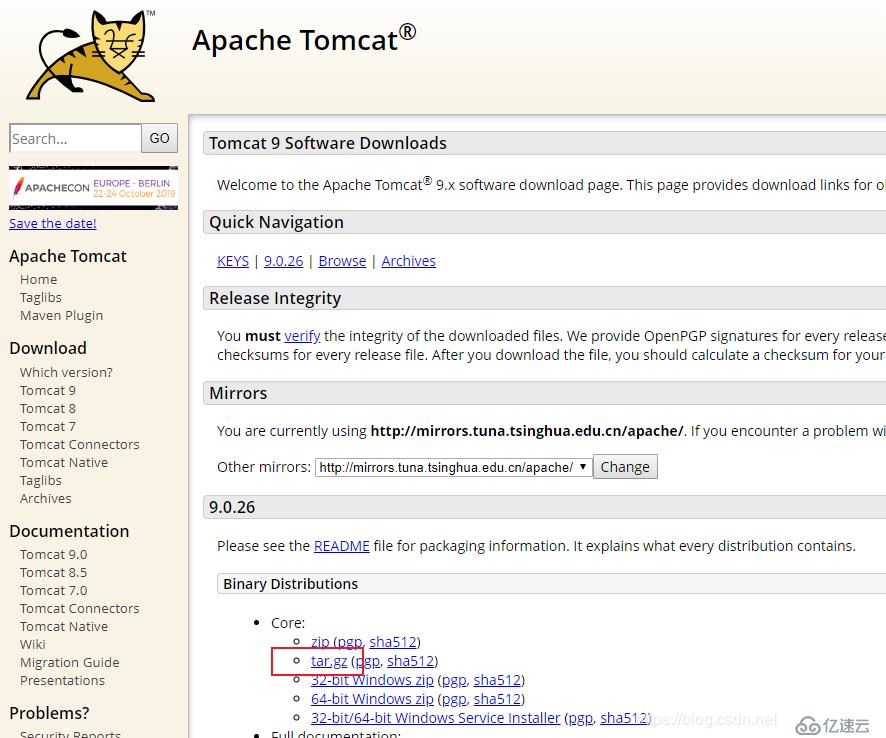
作者使用的是scp命令,不會的可以看這里
scp apache-tomcat-xxxx.tar.gz username@xx.xx.xx.xx:/改成自己的用戶名和ip
mkdir /usr/local/tomcat
mv apache-tomcat-xxxx.tar.gz /usr/local/tomcat
tar -xzvf apache-tomcat-xxx.tar.gz修改conf/server.xml文件,一般只需修改
<Connector port="8080" protocol="HTTP/1.1" connectionTimeout="20000" redirectPort="8443" />中的8080端口,修改這個端口即可
這個懶的話(比如作者)可以不改
運行bin目錄下的startup.sh
cd bin
./startup.sh瀏覽器輸入
服務器IP:端口若出現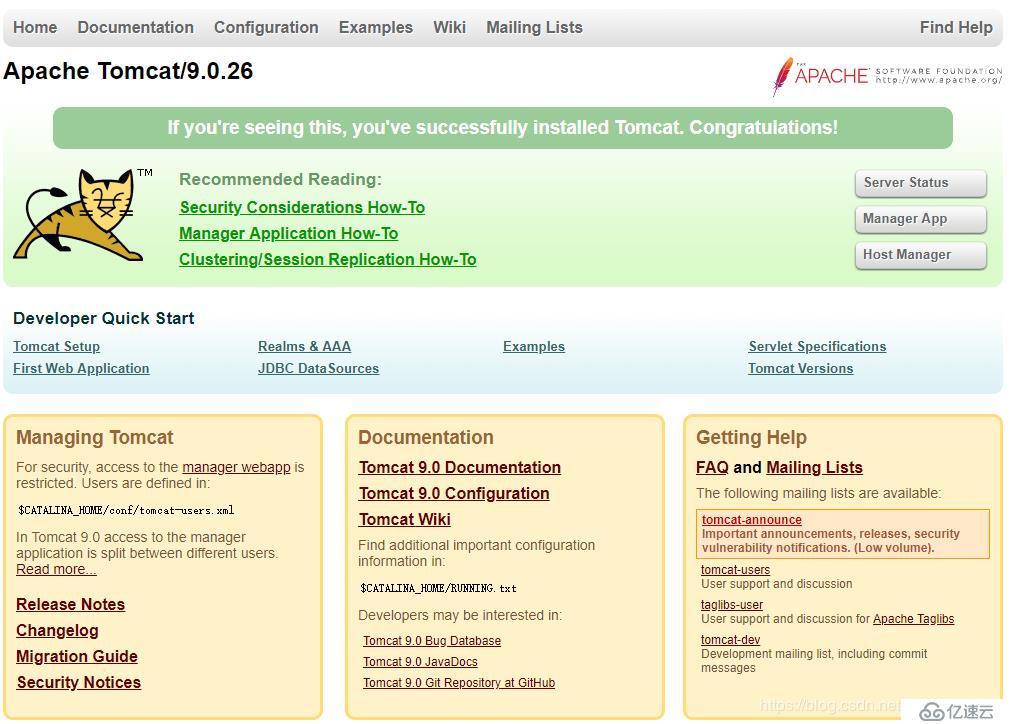
則表示成功.
建議配置開機啟動,修改/etc/rc.local文件
vim /etc/rc.local
添加
sh /usr/local/tomcat/bin/startup.sh這個根據自己的tomcat安裝路徑修改,指定bin下的startup.sh即可
創建用戶表,這里簡化操作(好吧我喜歡偷懶)就不創建新用戶不授權了
這是一個在本地用root登錄的示例,請根據實際情況創建并授權用戶.
CREATE DATABASE userinfo;
USE userinfo;
CREATE TABLE user
(
id INT NOT NULL PRIMARY KEY AUTO_INCREMENT,
name CHAR(30) NULL,
password CHAR(30) NULL
);mysql -u root -p < user.sql
選擇web application
選好路徑,改好名字后finish
創建一個叫lib的目錄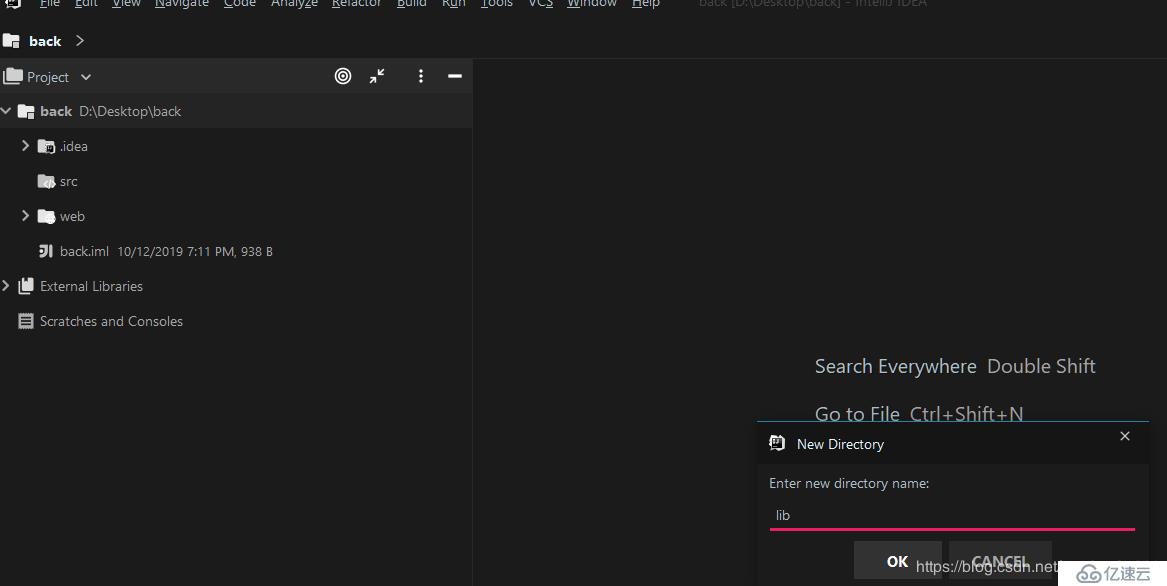
添加兩個jar包:
mysql-connector-java-8.0.17.jar
javax.servlet-api-4.0.1.jar
打開Project Structure
Modules--> + --> JARs or directories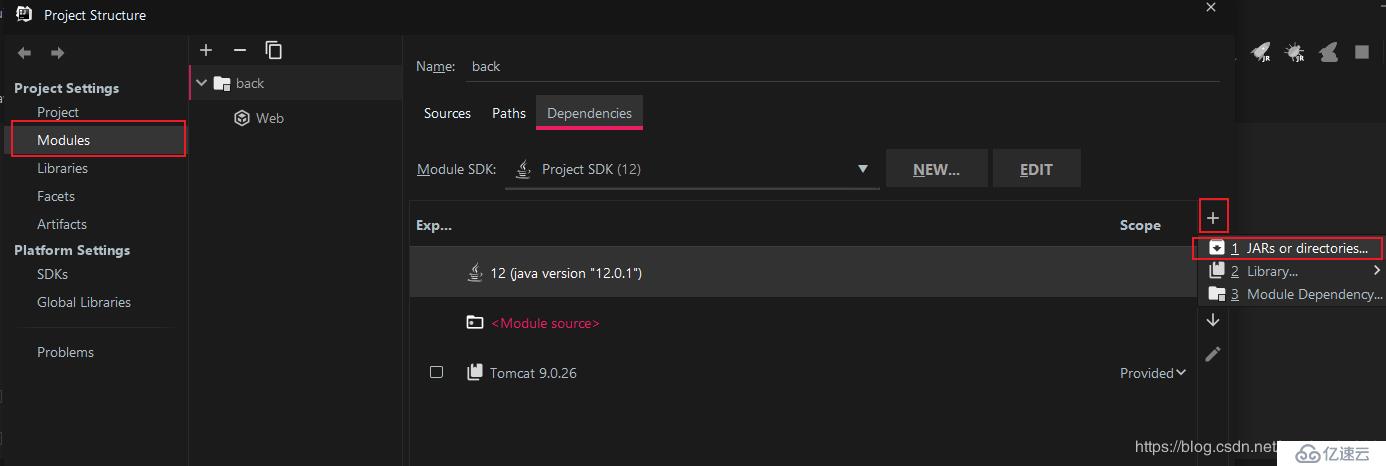
選擇剛才新建的lib下的兩個jar包
打勾,apply
總共4個包

這個是連接數據庫的類,純粹的底層jdbc實現,注意驅動版本.
package com.util;
import java.sql.*;
public class DBUtils {
private static Connection connection = null;
public static Connection getConnection()
{
try {
Class.forName("com.mysql.cj.jdbc.Driver");
String url = "jdbc:mysql://127.0.0.1:3306/數據庫名字";
String usename = "賬號";
String password = "密碼";
connection = DriverManager.getConnection(url,usename,password);
}
catch (Exception e)
{
e.printStackTrace();
return null;
}
return connection;
}
public static void closeConnection()
{
if(connection != null)
{
try {
connection.close();
}
catch (SQLException e)
{
e.printStackTrace();
}
}
}
}主要就是獲取連接與關閉連接兩個函數.
String url = "jdbc:mysql://127.0.0.1:3306/數據庫名字";
String usename = "賬號";
String password = "密碼";這幾行根據自己的用戶名,密碼,服務器ip和庫名修改
注意,mysql8.0以上使用的注冊驅動的語句是
Class.forName("com.mysql.cj.jdbc.Driver");舊版的是
Class.forName("com.mysql.jdbc.Driver");注意對應.
User類比較簡單,就是就三個字段與getter,setter
package com.entity;
public class User {
private int id;
private String name;
private String password;
public int getId() {
return id;
}
public void setId(int id) {
this.id = id;
}
public String getName() {
return name;
}
public void setName(String name) {
this.name = name;
}
public String getPassword() {
return password;
}
public void setPassword(String password) {
this.password = password;
}
}package com.dao;
import com.entity.User;
import com.util.DBUtils;
import java.sql.Connection;
import java.sql.PreparedStatement;
import java.sql.ResultSet;
import java.sql.SQLException;
public class UserDao {
public boolean query(User user)
{
Connection connection = DBUtils.getConnection();
String sql = "select * from user where name = ? and password = ?";
try {
PreparedStatement preparedStatement = connection.prepareStatement(sql);
preparedStatement.setString(1,user.getName());
preparedStatement.setString(2,user.getPassword());
ResultSet resultSet = preparedStatement.executeQuery();
return resultSet.next();
}
catch (SQLException e)
{
e.printStackTrace();
return false;
}
finally {
DBUtils.closeConnection();
}
}
public boolean add(User user)
{
Connection connection = DBUtils.getConnection();
String sql = "insert into user(name,password) values(?,?)";
try {
PreparedStatement preparedStatement = connection.prepareStatement(sql);
preparedStatement.setString(1,user.getName());
preparedStatement.setString(2,user.getPassword());
preparedStatement.executeUpdate();
return preparedStatement.getUpdateCount() != 0;
}
catch (SQLException e)
{
e.printStackTrace();
return false;
}
finally {
DBUtils.closeConnection();
}
}
}主要就是查詢與添加操作,查詢操作中存在該用戶就返回true,否則返回false
添加操作中使用executeUpdate()與getUpdateCount() != 0.注意不能直接使用
return preparedStatement.execute();去代替
preparedStatement.executeUpdate();
return preparedStatement.getUpdateCount() != 0;咋一看好像沒有什么問題,那天晚上我測試的時候問題可大了,android那邊顯示注冊失敗,但是數據庫這邊的卻insert進去了.........我......
好吧說多了都是淚,還是函數用得不夠熟練.<br><br>
所以在這個例子中
return preparedStatement.execute();肯定返回false,所以才會數據庫這邊insert進去,但前端顯示注冊失敗(這個bug作者找了很久......)
SingIn類用于處理登錄,調用jdbc查看數據庫是否有對應的用戶
SignUp類用于處理注冊,把user添加到數據庫中
這兩個使用的是http連接,后期作者會采用https加密連接.
SignIn.java
package com.servlet;
import com.dao.UserDao;
import com.entity.User;
import javax.servlet.ServletException;
import javax.servlet.annotation.WebServlet;
import javax.servlet.http.HttpServlet;
import javax.servlet.http.HttpServletRequest;
import javax.servlet.http.HttpServletResponse;
import java.io.IOException;
@WebServlet("/SignIn")
public class SingIn extends HttpServlet {
@Override
protected void doGet(HttpServletRequest httpServletRequest, HttpServletResponse httpServletResponse) throws IOException,ServletException
{
this.doPost(httpServletRequest,httpServletResponse);
}
@Override
protected void doPost(HttpServletRequest httpServletRequest,HttpServletResponse httpServletResponse) throws IOException, ServletException
{
httpServletRequest.setCharacterEncoding("utf-8");
httpServletResponse.setCharacterEncoding("utf-8");
httpServletResponse.setContentType("text/plain;charset=utf-8");//設置相應類型為html,編碼為utf-8
String name = httpServletRequest.getParameter("name");
String password = httpServletRequest.getParameter("password");
UserDao userDao = new UserDao();
User user = new User();
user.setName(name);
user.setPassword(password);
if(!userDao.query(user))//若查詢失敗
{
httpServletResponse.sendError(204,"query failed.");//設置204錯誤碼與出錯信息
}
}
}
@WebServlet("/SignIn")這行代碼表示這是一個名字叫SignIn的servlet,可用于實現servlet與url的映射,如果不在這里添加這個注解,則需要在WEB-INF目錄下的web.xml添加一個
<servlet-mapping>叫servlet的映射
httpServletResponse.setContentType("text/plain;charset=utf-8");//設置相應類型為html,編碼為utf-8這行代碼設置響應類型與編碼
String name = httpServletRequest.getParameter("name");
String password = httpServletRequest.getParameter("password");HttpServletRequest.getParameter(String name)方法表示根據name獲取相應的參數
下面是SignUp.java
package com.servlet;
import com.dao.UserDao;
import com.entity.User;
import javax.servlet.annotation.*;
import javax.servlet.http.*;
import javax.servlet.*;
import java.io.IOException;
@WebServlet("/SignUp")
public class SignUp extends HttpServlet {
@Override
protected void doGet(HttpServletRequest httpServletRequest,HttpServletResponse httpServletResponse) throws IOException,ServletException
{
this.doPost(httpServletRequest,httpServletResponse);
}
@Override
protected void doPost(HttpServletRequest httpServletRequest,HttpServletResponse httpServletResponse) throws IOException,ServletException
{
httpServletRequest.setCharacterEncoding("utf-8");
httpServletResponse.setCharacterEncoding("utf-8");//設定編碼防止中文亂碼
httpServletResponse.setContentType("text/plain;charset=utf-8");//設置相應類型為html,編碼為utf-8
String name = httpServletRequest.getParameter("name");//根據name獲取參數
String password = httpServletRequest.getParameter("password");//根據password獲取參數
UserDao userDao = new UserDao();
User user = new User();
user.setName(name);
user.setPassword(password);
if(!userDao.add(user)) //若添加失敗
{
httpServletResponse.sendError(204,"add failed.");//設置204錯誤碼與出錯信息
}
}
}
<?xml version="1.0" encoding="UTF-8"?>
<web-app xmlns="http://xmlns.jcp.org/xml/ns/javaee"
xmlns:xsi="http://www.w3.org/2001/XMLSchema-instance"
xsi:schemaLocation="http://xmlns.jcp.org/xml/ns/javaee http://xmlns.jcp.org/xml/ns/javaee/web-app_4_0.xsd"
version="4.0">
<servlet>
<servlet-name>SignIn</servlet-name>
<servlet-class>com.servlet.SingIn</servlet-class>
</servlet>
<servlet>
<servlet-name>SignUp</servlet-name>
<servlet-class>com.servlet.SignUp</servlet-class>
</servlet>
</web-app>要把剛才創建的Servlet添加進web.xml,在<servlet>中添加子元素<servlet-name>與<servlet-class>
<servlet-name>是Servlet的名字,最好與類名一致.
<servlet-class>是Servlet類的位置.
如果在Servlet類中沒有添加
@WebServlet("/xxxx")這個注解,則需要在web.xml中添加
<servlet-mapping>
<servlet-name>SignIn</servlet-name>
<url-pattern>/SignIn</url-pattern>
</servlet-mapping>其中<servlet-name>與<servlet>中的子元素<servlet-name>中的值一致
<url-pattern>是訪問的路徑
<!DOCTYPE html>
<head>
<meta charset="utf-8">
<title>Welcome</title>
</head>
<body>
Hello web.
</body>
</html><br><br><br>
作者用的是IDEA,Eclipse的打包請看這里




(那個lib文件夾被擋住了.....)
web.xml這個需要在WEB-INF目錄里,Hello.html在WEB-INF外面


把打包好的.war文件上傳到服務器的tomcat的/webapps目錄下的
scp ***.war username@xxx.xxx.xxx.xxx:/usr/local/tomcat/webapps注意改成自己的webapps目錄.
在瀏覽器輸入
服務器IP:端口/項目/Hello.html作者是在本地上開了tomcat后測試的


package com.cx;
import android.os.Bundle;
import android.view.View;
import android.widget.Button;
import android.widget.EditText;
import android.widget.Toast;
import androidx.appcompat.app.AppCompatActivity;
public class MainActivity extends AppCompatActivity {
@Override
protected void onCreate(Bundle savedInstanceState) {
super.onCreate(savedInstanceState);
setContentView(R.layout.activity_main);
Button signin = (Button) findViewById(R.id.signin);
signin.setOnClickListener(new View.OnClickListener() {
@Override
public void onClick(View view) {
String name = ((EditText) findViewById(R.id.etname)).getText().toString();
String password = ((EditText) findViewById(R.id.etpassword)).getText().toString();
if (UserService.signIn(name, password))
runOnUiThread(new Runnable() {
@Override
public void run() {
Toast.makeText(MainActivity.this, "登錄成功", Toast.LENGTH_SHORT).show();
}
});
else {
runOnUiThread(new Runnable() {
@Override
public void run() {
Toast.makeText(MainActivity.this, "登錄失敗", Toast.LENGTH_SHORT).show();
}
});
}
}
});
Button signup = (Button) findViewById(R.id.signup);
signup.setOnClickListener(new View.OnClickListener() {
@Override
public void onClick(View view) {
String name = ((EditText) findViewById(R.id.etname)).getText().toString();
String password = ((EditText) findViewById(R.id.etpassword)).getText().toString();
if (UserService.signUp(name, password))
runOnUiThread(new Runnable() {
@Override
public void run() {
Toast.makeText(MainActivity.this, "注冊成功", Toast.LENGTH_SHORT).show();
}
});
else {
runOnUiThread(new Runnable() {
@Override
public void run() {
Toast.makeText(MainActivity.this, "注冊失敗", Toast.LENGTH_SHORT).show();
}
});
}
}
});
}
}沒什么好說的,就為兩個Button綁定事件,然后設置兩個Toast提示信息.
package com.cx;
import java.io.OutputStream;
import java.net.HttpURLConnection;
import java.net.URL;
import java.net.URLEncoder;
public class UserService {
public static boolean signIn(String name, String password) {
MyThread myThread = new MyThread("http://本機IP:8080/cx/SignIn",name,password);
try
{
myThread.start();
myThread.join();
}
catch (InterruptedException e)
{
e.printStackTrace();
}
return myThread.getResult();
}
public static boolean signUp(String name, String password) {
MyThread myThread = new MyThread("http://本機IP:8080/cx/SignUp",name,password);
try
{
myThread.start();
myThread.join();
}
catch (InterruptedException e)
{
e.printStackTrace();
}
return myThread.getResult();
}
}
class MyThread extends Thread
{
private String path;
private String name;
private String password;
private boolean result = false;
public MyThread(String path,String name,String password)
{
this.path = path;
this.name = name;
this.password = password;
}
@Override
public void run()
{
try {
URL url = new URL(path);
HttpURLConnection httpURLConnection = (HttpURLConnection) url.openConnection();
httpURLConnection.setConnectTimeout(8000);//設置連接超時時間
httpURLConnection.setReadTimeout(8000);//設置讀取超時時間
httpURLConnection.setRequestMethod("POST");//設置請求方法,post
String data = "name=" + URLEncoder.encode(name, "utf-8") + "&password=" + URLEncoder.encode(password, "utf-8");//設置數據
httpURLConnection.setRequestProperty("Content-Type", "application/x-www-form-urlencoded");//設置響應類型
httpURLConnection.setRequestProperty("Content-Length", data.length() + "");//設置內容長度
httpURLConnection.setDoOutput(true);//允許輸出
OutputStream outputStream = httpURLConnection.getOutputStream();
outputStream.write(data.getBytes("utf-8"));//寫入數據
result = (httpURLConnection.getResponseCode() == 200);
} catch (Exception e) {
e.printStackTrace();
}
}
public boolean getResult()
{
return result;
}
}MyThread myThread = new MyThread("http://本機IP:8080/cx/SignUp",name,password);
MyThread myThread = new MyThread("http://本機IP:8080/cx/SignIn",name,password);這兩行換成自己的ip,本地ip的話可以用ipconfig或ifconfig查看,修改了默認端口的話也把端口一起改了.
路徑的話就是
端口/web項目名/Servlet名web項目名是再打成war包時設置的,Servlet名在web.xml中的<servlet>的子元素<servlet-name>設置,與java源碼中的@WebServlet()注解中的一致
另外一個要注意的就是線程問題,需要新開一個線程進行http的連接
前端頁面部分很簡單,就兩個button,用于驗證功能.
<?xml version="1.0" encoding="utf-8"?>
<LinearLayout
xmlns:app="http://schemas.android.com/apk/res-auto"
xmlns:android="http://schemas.android.com/apk/res/android"
android:layout_height="match_parent"
android:layout_width="match_parent"
android:orientation="vertical"
>
<LinearLayout
android:layout_width="wrap_content"
android:layout_height="wrap_content"
android:orientation="horizontal">
<TextView
android:layout_width="wrap_content"
android:layout_height="wrap_content"
android:text="用戶名"
/>
<EditText
android:layout_width="300dp"
android:layout_height="60dp"
android:id="@+id/etname"
/>
</LinearLayout>
<LinearLayout
android:layout_width="wrap_content"
android:layout_height="wrap_content"
android:orientation="horizontal">
<TextView
android:layout_width="wrap_content"
android:layout_height="wrap_content"
android:text="密碼"
/>
<EditText
android:layout_width="300dp"
android:layout_height="60dp"
android:id="@+id/etpassword"
/>
</LinearLayout>
<LinearLayout
android:layout_width="wrap_content"
android:layout_height="wrap_content"
android:orientation="horizontal">
<Button
android:layout_width="120dp"
android:layout_height="60dp"
android:text="注冊"
android:id="@+id/signup"
/>
<Button
android:layout_width="120dp"
android:layout_height="60dp"
android:text="登錄"
android:id="@+id/signin"
/>
</LinearLayout>
</LinearLayout>隨便輸入用戶名與密碼
查看數據庫
這里沒有加密保存,后期會添加加密保存

perfect!

這個錯誤在加載驅動錯誤時也可能會出現這個錯誤,因此要確保打成war包時lib目錄正確且jar包版本正確.
還有就是由于這個是jdbc的底層實現,注意手寫的sql語句不能錯
千萬千萬別像我這樣:
這個需要在AndroidManifest.xml添加網絡權限
<uses-permission android:name="android.permission.INTERNET" />
<uses-permission android:name="android.permission.ACCESS_WIFI_STATE" />
<uses-permission android:name="android.permission.ACCESS_NETWORK_STATE" />服務器的話一般會有相應的相應的網頁界面配置,比如作者的是阿里云服務器,當然也可以手動配置iptables
修改/etc/sysconfig/iptables
vim /etc/sysconfig/iptables添加
-A INPUT -m state --state NEW -m tcp -p tcp --dport 8080 -j ACCEPT
-A RH-Firewall-1-INPUT -m state --state NEW -m tcp -p tcp --dport 8080 -j ACCEPT重啟iptables
service iptables restart由于從Android P開始,google默認要求使用加密連接,即要使用HTTPS,所以會禁止使用HTTP連接
使用HTTP連接時會出現以下異常
W/System.err: java.io.IOException: Cleartext HTTP traffic to **** not permitted
java.net.UnknownServiceException: CLEARTEXT communication ** not permitted by network security policy兩種建議:
在res下新建一個文件夾xml,創建一個叫network_security_config.xml的文件,文件內容如下
<?xml version="1.0" encoding="utf-8"?>
<network-security-config>
<base-config cleartextTrafficPermitted="true" />
</network-security-config>然后在AndroidMainfest.xml中加入
<application
android:networkSecurityConfig="@xml/network_security_config"
/>即可
另一種辦法是直接加入一句
android:usesCleartextTraffic="true"<application
android:usesCleartextTraffic="true"
/>
從android4.0開始,聯網不能再主線程操作,萬一網絡不好就會卡死,所以有關聯網的操作都需要新開一個線程,不能在主線程操作.
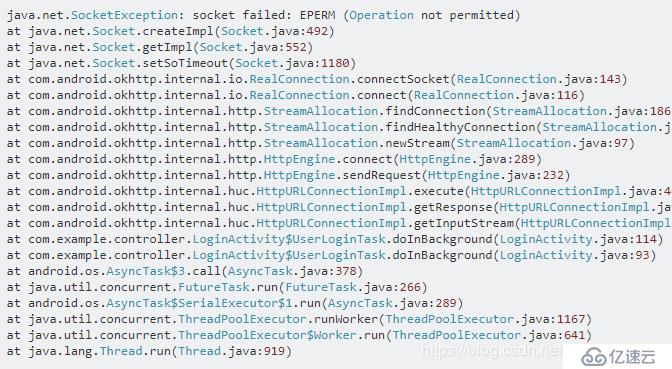
這個bug作者找了很久,http連接沒問題,服務器沒問題,數據庫沒問題,前端代碼沒問題,然后去了stackoverflow,發現是AVD的問題,我.......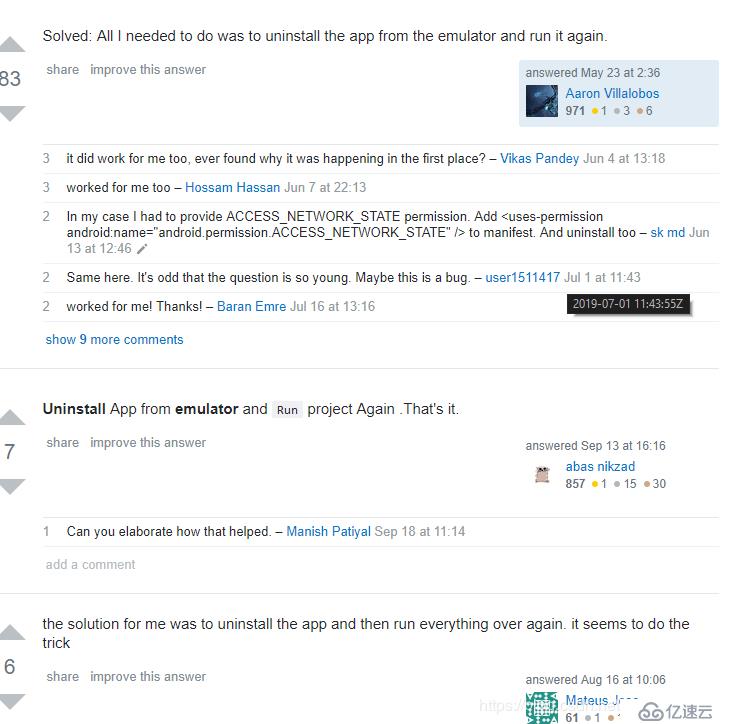
簡單來說就是卸載了再重啟AVD,居然成功了.....
參考網站
1.Android 通過Web服務器與Mysql數據庫交互
2.Android高版本聯網失敗
3.IDEA 部署Web項目
4.PreparedStatement的executeQuery、executeUpdate和execute
5.preparedstatement execute()操作成功!但是返回false
6.HttpServletResponse(一)
7.HttpServletResponse(二)
8.HttpServletRequest
9.HttpUrlConnection
10.java.net.socketexception
免責聲明:本站發布的內容(圖片、視頻和文字)以原創、轉載和分享為主,文章觀點不代表本網站立場,如果涉及侵權請聯系站長郵箱:is@yisu.com進行舉報,并提供相關證據,一經查實,將立刻刪除涉嫌侵權內容。